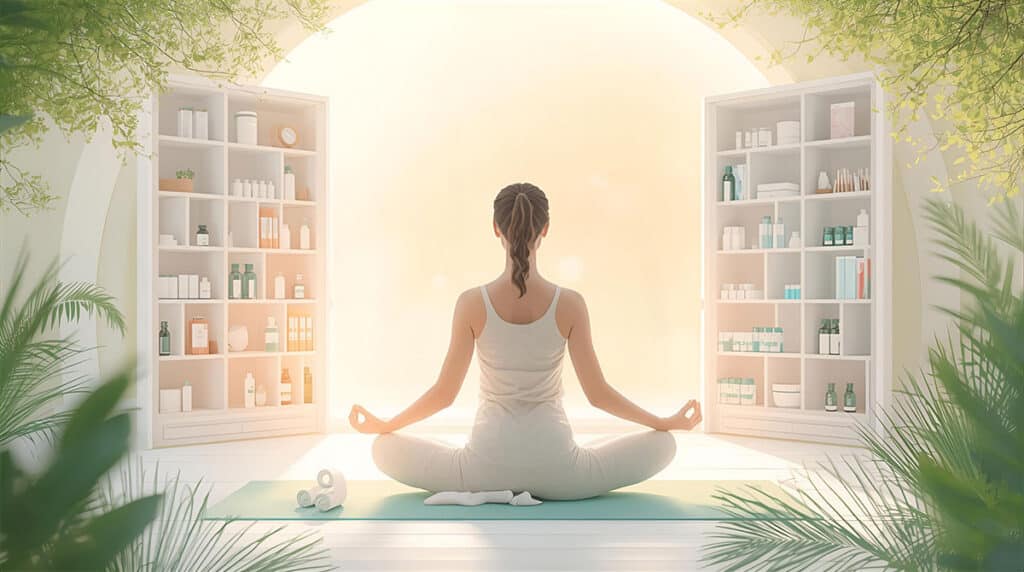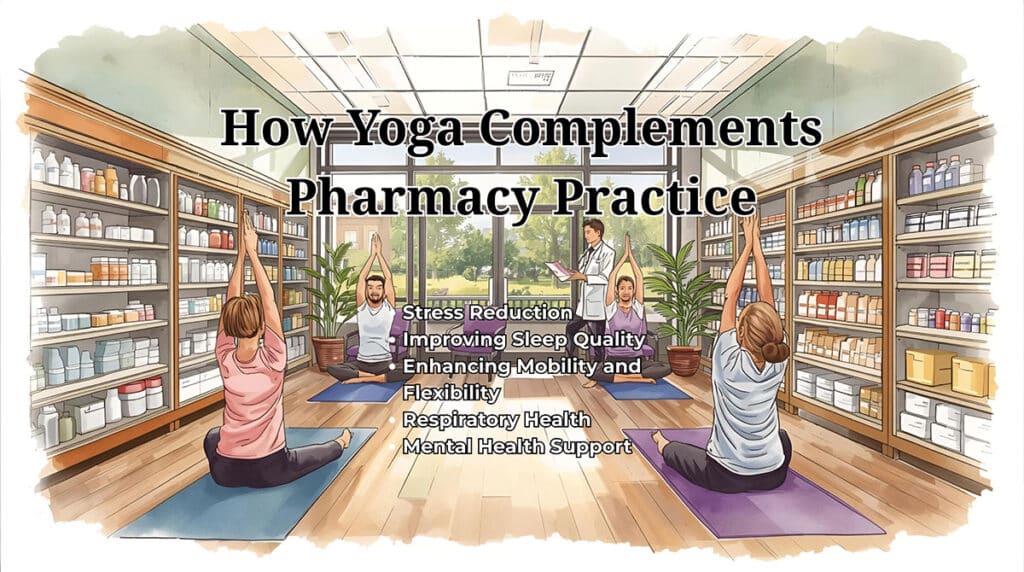Pharmacy Meets Yoga: Bridging Medicine and Mindfulness
by Hardik Mehta

Every year, World Pharmacy Day is observed on 25 September to recognize the role of pharmacists and the pharmacy profession in healthcare, safety, and the well-being of communities. This day highlights how pharmacies help people access essential medicines and advice, promote public health, and prevent disease. But what if we explore how yoga—an ancient practice of physical, mental, and spiritual wellbeing—can complement this mission? In this blog, we will discover the connections between World Pharmacy Day and yoga, and how integrating both can uplift health outcomes.
What Is World Pharmacy Day?
- Purpose: To recognize the value of pharmacists in public health, improve awareness of their role, and encourage collaboration with other health sectors.
- Themes: Each year, World Pharmacy Day focuses on a specific theme (e.g., “Pharmacy: Always trusted for your health”) that emphasizes trust, responsibility, access, and innovation.
- Importance: Pharmacists do more than dispense medicines. They counsel patients, help prevent medication errors, contribute to disease prevention (like vaccinations), and serve as accessible health advisers.
Yoga: A Brief Overview
Yoga is a holistic discipline that originated in ancient India. It combines:
- Physical postures (asanas) for strength, balance, and flexibility
- Breathing techniques (pranayama) to calm the nervous system
- Meditation and mindfulness to develop mental clarity and emotional stability
- Lifestyle and ethical principles to support overall wellness
Over decades, scientific research has validated many of yoga’s benefits: stress reduction, improved cardiovascular health, better flexibility and posture, enhanced respiratory function, and mental well-being.
Linking Pharmacy and Yoga: Shared Goals
While pharmacy and yoga might seem like separate fields, they share many common goals:
- Prevention over cure
Pharmacists educate on preventive measures like vaccination and a healthy diet. Yoga likewise supports preventive health by reducing risk factors (e.g., stress, hypertension, obesity). - Holistic health
Pharmacy addresses physical illnesses, symptoms, and therapeutic interventions. Yoga adds layers of mental, emotional, and lifestyle wellness. - Empowerment and awareness
Pharmacists counsel patients, giving knowledge about medicines and safe practices. Yoga teaches self-awareness, body awareness, breathing—tools people can use themselves. - Supporting chronic conditions
Conditions like diabetes, hypertension, arthritis, and anxiety often require both medical treatment and lifestyle changes. Yoga can be a supportive adjunct therapy alongside medication or pharmacy advice.
How Yoga Complements Pharmacy Practice
Here are specific ways yoga can work in tandem with pharmacy services:

- Stress Reduction: High stress can compromise the effectiveness of medication. Yoga reduces cortisol levels and improves mood, helping patients adhere to their treatment plans.
- Improving Sleep Quality: Many medications are meant to improve sleep or manage insomnia. Gentle yoga at bedtime can help the body relax and enhance sleep hygiene—with or without pharmacotherapy.
- Enhancing Mobility and Flexibility: Especially relevant for older adults or those with musculoskeletal issues. Yoga asanas support joint health and may reduce reliance on pain-relieving drugs (with due medical supervision).
- Respiratory Health: Pranayama techniques help with lung capacity and breathing efficiency. For those using inhalers or respiratory medications, yoga may help improve lung function.
- Mental Health Support: Conditions such as anxiety, depression, and stress disorders often accompany physical ailments. Yoga and meditation offer complementary benefits to psychological therapies or pharmacological support.
A Day to Celebrate Integration: How to Observe World Pharmacy Day with Yoga
Here are ideas for communities, pharmacies, yoga centres, and individuals to recognize World Pharmacy Day by combining pharmacy and yoga:
- Pharmacy-yoga workshops: Local clinics or pharmacies can organize sessions where yoga instructors conduct short classes, followed by pharmacists giving health talks about medicines, dosage safety, side effects, etc.
- Community events: Yoga in parks or open spaces in collaboration with pharmacist-led booths providing health screenings (blood pressure, blood sugar) and dispensing health advice.
- Digital awareness campaigns: Use social media to promote tips such as “5 yoga poses for stress relief” plus “ways to safely use your medicines.” Use infographics that combine both areas.
- Pharmacists practising yoga: Encouraging pharmacists themselves to practice yoga to manage their work stress, maintain posture (especially if they spend long hours standing), and keep their lifespan wellness in check.
Evidence and Research
Recent studies have supported the benefits of yoga for many health conditions:
- Cardiovascular health: Yoga lowers blood pressure, reduces heart rate variability, and improves circulation.
- Metabolic disorders: Regular yoga practice contributes to better glucose control in type 2 diabetes.
- Mental health: Multiple trials show yoga reduces symptoms of anxiety and depression.
- Musculoskeletal issues: Back pain, arthritis, joint stiffness often improve with regular gentle yoga practice.
Pharmacists can refer patients to scientifically backed yoga resources or integrate them into therapy plans, where safe and applicable.
Safety Considerations
While yoga is generally safe, combining it with medical treatment requires care:
- Always consult with a healthcare professional (pharmacist, doctor) before starting yoga if you have a chronic illness or are taking medications that affect balance or cardiovascular function.
- Certain yoga poses might be contraindicated for people with conditions like glaucoma, spine issues, or pregnancy, so modifications are needed.
- Never discontinue prescribed medication in favour of yoga alone without professional advice.
Bringing It All Together: Why the Synergy Matters
- Enhancing quality of life is central: when pharmacy and yoga work together, the result is not just treating illness, but reinforcing strength, resilience, and daily wellness.
- Cost-effectiveness: reducing dependency on some medications by preventive lifestyle measures (including yoga) may reduce healthcare costs.
- Empathy and patient-centred care: the pharmacy profession is strengthened by recognizing the person behind the prescription—and yoga supports connection to self and mind-body harmony.
Sayujya Yoga and Your Health Journey
If you’re looking for a partner to help you integrate yoga into your life in a balanced, safe, and professional way, Sayujya Yoga is an excellent resource.
How Sayujya Yoga Connects to World Pharmacy Day Themes
- Holistic wellness approach: Sayujya Yoga emphasises not just physical asana practice, but breathing, meditation, and lifestyle guidance—a synergy which aligns with preventive and integrated health models supported by pharmacy.
- Responsibility and awareness: Just as pharmacists educate patients, Sayujya Yoga trains practitioners and students to become more aware of their bodies, habits, and mental well-being.
Services That May Meet Your Needs
At Sayujya Yoga, the offerings go beyond physical postures or general wellness—they aim to build a sustainable foundation for yoga practitioners and teachers alike. Here are some services that align with holistic health and complement the philosophy of balance, just as pharmacy does with medicine:
- RYS 200 Compliant Curriculum
Sayujya Yoga follows the Yoga Alliance–recognized RYS 200 (Registered Yoga School 200-hour) curriculum. This ensures that students receive structured, internationally credible training that covers yoga philosophy, anatomy, teaching methodology, and practical sessions. It’s a perfect balance of tradition and modern guidance, similar to how pharmacy combines science with care.
- Detailed Manual for Reference
Students are provided with a comprehensive yoga manual, serving as a lifelong reference. Much like a pharmacist provides detailed information about medicines and dosages, Sayujya Yoga equips learners with knowledge they can revisit whenever needed—whether for personal practice or professional teaching.
- Individual Attention to All
Unlike large, impersonal classes, Sayujya Yoga emphasises personalised attention. Each student’s strengths, challenges, and progress are recognised, ensuring a safe and supportive learning environment. This mirrors the way a pharmacist ensures each prescription is tailored to an individual’s health condition.
- Lifetime Support and Mentoring
The journey doesn’t end after completing a program. Sayujya Yoga offers ongoing mentorship and lifetime guidance, enabling students to continue their growth and resolve challenges even years after training. This commitment reflects the same long-term trust people place in healthcare providers.
- Online Students Community
Sayujya Yoga has built an active online community, where students can share experiences, ask questions, and access continuous learning. This supportive environment ensures learners never feel isolated in their journey—similar to how healthcare professionals and patients form a network of trust and collaboration.
If you are someone taking medication or under pharmaceutical care, Sayujya Yoga can help you add yoga safely into your routine to enhance health, relieve side effects like stress or sleeplessness, and boost quality of life overall.
Conclusion
World Pharmacy Day is not only a day to honour pharmacists and all they do—it is also a reminder that health is a multidimensional concept. When combined with the ancient wisdom of yoga, we see a path to better prevention, improved wellness, and more resilient communities. Whether you are a healthcare professional, yoga practitioner, or someone wishing to improve your everyday health, the synergy between pharmacy and yoga offers value, safety, and hope.
On this World Pharmacy Day, consider how yoga might support your own medical journey, and seek professionals—pharmacists, yoga teachers—who value holistic health. With the right balance, we can move beyond treating symptoms to nurturing lasting wellbeing.
About the Author

Hardik Mehta
Hardik is an E-RYT 500 & YACEP (Yoga Alliance Continuing Education Provider), Yoga Alliance, USA. He has been practicing yoga for the last 9 years. Prior to finding his true calling in Yoga, he was working with various corporates for 12 years in the Retail and eCommerce sector.
